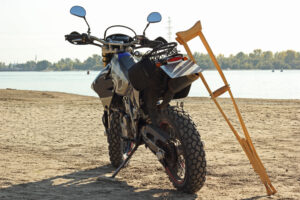 If you ride a motorcycle, chances are no one has to tell you it can be hazardous. If it weren’t, May wouldn’t be National Motorcycle Safety Month.
If you ride a motorcycle, chances are no one has to tell you it can be hazardous. If it weren’t, May wouldn’t be National Motorcycle Safety Month.
The key to that feeling of pure, unburdened freedom on the road, the reason you ride, is making sure everything is in order with your bike, to begin with. A quick safety check before you go out will set your mind at ease and ensure that you’re well-equipped to tackle any conditions that come your way.
The Motorcycle Safety Foundation came up with a safety checklist that can be called to mind with the acronym T-CLOCS. It stands for “tires, controls, lights, oil, chassis and side stand.” Here is a brief rundown of what each step in the safety check entails.
Tires and wheels
If you have an issue with your tires, it may give you problems controlling your bike. For the wheels, make sure the rims have no dings and that the spokes are straight and tight.
Look through your owner’s manual or call the manufacturer to see at what pressure your tires should be while “cold” — before you start riding. Also, check that you have a good amount of tire tread. You should have over one-sixteenth of an inch of tread. If any small objects, like rocks or twigs, have lodged in your tires, pick them out. Look for cuts and deep scratches– these can present a problem.
Controls and cables
To check that your cables are intact, operate all controls connected to the cables. The cables should be operating smoothly, without binding.
Check brakes by pressing your front brake and pushing the bike forward, making sure the wheel doesn’t move at all. Do the same with the back brake and the back wheel.
Lights
Check the high beam and low beam, the brake lights, turn signals and taillights. Test out your horn.
Oil and gas
Be sure to do this step — it’s especially important if your bike lacks a gas gauge.
Make sure your fuel petcock isn’t on “reserve,” which might give you a false sense that you have more fuel than you do.
Running out of oil can spell death for your engine, so checking the oil level is critical. Do this often.
Chassis
The suspension on your bike, if not set right, could affect handling.
To test the suspension, sit on your bike and rock it. If everything moves fairly smoothly and slowly, you’re good.
If you’re not sure how to set your suspension, look through your manual for the proper setting.
Sidestand and center stand
Make sure these are working well and that there is enough tension in the springs to keep the bike well supported. Also, take a look at your bike’s engine cut-out switch or pad, if you have those.
All motorcyclists should take the necessary precautions and be safe on the road. But sometimes they are injured when other drivers are careless. If you are hurt because someone was driving irresponsibly, you may be owed damages.
If you or a loved one has been injured in a motorcycle accident or other accident involving the negligence of someone else, the experienced personal injury attorneys at Alpert Schreyer, LLC can help. We will listen to you, review your case, and get you the compensation you deserve so you can move forward.
